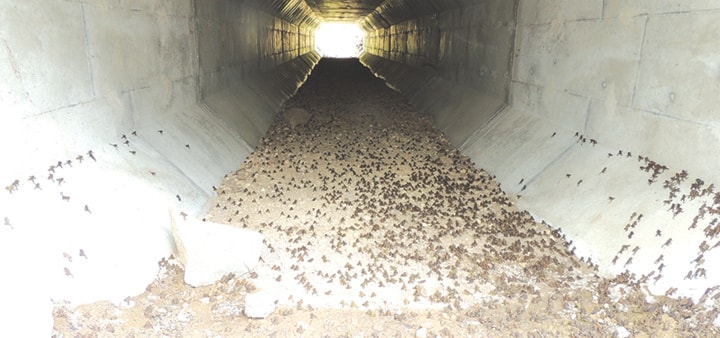The warm spring in 2016 has resulted in the earliest breeding of Western Toads at Summit Lake in the last 20 years, so there will likely be another early migration of toadlets this summer. The new toad tunnel, recently installed by the Ministry of Transportation and Infrastructure is anticipated to be well-utilized by the toadlets, possibly by as early as mid-July.
The toads did not have sole use of the new tunnel; remote cameras captured nine other vertebrate species — including a Pacific Wren — using it. This was just one finding among the results from 2015 of the Summit Lake Western Toad Research Project, now in its sixth year of data collection and monitoring.
In 2015, the toadlet migration occurred during the last two weeks of July with nearly all of the toadlets moving by mid-August. Although there was no estimate of total toadlet population, anecdotal evidence suggests it was a bumper migration at Summit Lake.
The tunnel is just one part of the solution to help the Western Toad. Biologists with the Ministry of Forests, Lands and Natural Resource Operations (FLNRO), with funding from the Fish & Wildlife Compensation Program (FWCP), have increased and improved the wildlife fencing that guides the toadlets and adults into the new larger tunnel, as well as the two existing smaller tunnels.
Despite the infrastructure improvements, getting safely across the highway remains one of the challenges the toads face at Summit Lake. Of special concern are the adult females, each of which can carry up to 16,000 eggs. In the 2015 field research, of 415 adult toads detected during the highway surveys, 218 were alive and 197 dead. Two-thirds of the dead females were carrying eggs. Identifying and implementing measures to reduce highway mortality of adult toads remains a top priority.
Other highlights from the 2015 research include a toad that was tracked via radio telemetry over 89 days, and an adult female that covered more than 2.3 kilometres during a 38-day period.
Thirteen hibernacula (hibernation sites) were located and it was found that adult toads tend not to hibernate with other adult toads as they have been found to in the northern Boreal forest, but they may share hibernation quarters with toadlets.
Finally, the 2015 Summit Lake Western Toad Research Project report will be posted on the FWCP website at fwcp.ca. Research will continue in 2016 and information gathered will be used to evaluate options to maintain the Western Toad population at Summit Lake, and improve habitat connectivity between breeding and overwintering sites.
“The Western Toad is a focal species for us, as identified in our Species of Interest Action Plan, due to the fact that it has a high conservation concern, and we want to take an integrated approach with our partners in helping them.” said FWCP Columbia Region Manager, Crystal Klym. “Our role is to provide the best technical information to support the restoration and conservation of this population at Summit Lake.”
The FWCP is a partnership between BC Hydro, the Province of B.C., Fisheries and Oceans Canada, First Nations and Public Stakeholders, to conserve and enhance fish and wildlife impacted by BC Hydro dams. The FWCP does not make any land use decisions, nor is it involved in the review or approval of timber harvesting or industrial activities.
Due to the anticipated early toadlet migration this year, Toadftest at Summit Lake Provincial Park — which raises awareness about the species—has been scheduled for the evening of July 27 and the morning of July 28. For the latest information on Toadfest visit fwcp.ca.
